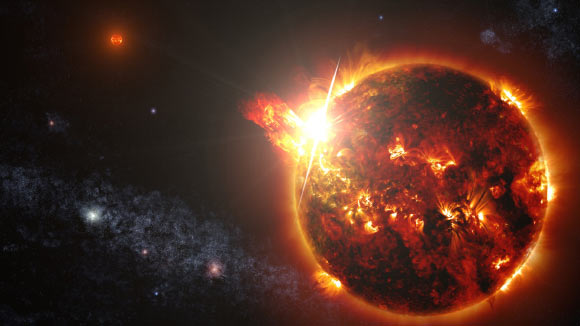TESS Catches Superflares from 400 Solar-Type Stars | Astronomy – Sci-News.com
Astronomers using NASA’s Transiting Exoplanet Survey Satellite (TESS) have detected 1,216 superflare events on 400 solar-type stars. One of these stars, called TIC 43472154, releases about 233 superflares per year.

An artist’s impression of a superflaring star. Image credit: NASA’s Goddard Space Flight Center / S. Wiessinger / Swift.
Our Sun bathes the Earth in energy, which supports biosphere and keeps the planet at a temperature suitable for liquid water to persist at the surface.
However, the Sun can also release large bursts of energy in the form of solar flares or coronal mass ejections.
Some stars in the Milky Way — especially young stars — experience so-called superflares, which can be orders of magnitude more powerful than the largest solar flares.
These events can significantly impact the potential habitability of rocky planets through atmospheric erosion or intense radiation exposure.
“Superflares are much stronger explosions than typical solar flares, with total energies varying from 1033 to 1038erg and duration longer than an hour,” said Nanjing University astronomer Zuo-Lin Tu and colleagues.
“The energy of a superflare is so high that can directly cause destructive attack to nearby living creatures.”
“It therefore has attracted people’s interests whether our Sun can generate superflares, just like the nine main sequence F8-G8 stars near our Solar System.”
Using data from TESS, Dr. Tu and co-authors looked at 25,734 solar-type stars (stars with a surface temperature between 5,600 and 6,000 K and a surface gravity in log scale greater than 4) located in the southern hemisphere of the sky.
The astronomers detected 1,216 superflares from 400 solar-type stars.
Only 7 of these events were detected on Sun-like stars (solar-type stars with a surface temperature between 5,600 and 6,000 K and a stellar periodicity higher than 10 days).
“According to statistics from all solar-type stars, hotter stars (5,600-6,000 K) have lower superflare frequency than cooler stars (5,100-5,600 K),” they said.
“Rapidly-rotating stars (with a period less than 10 days) are more active than slowly-rotating stars (with a period over 10 days).”
The most active star in the dataset, TIC 43472154, has an occurrence rate of 233.17 superflares per year.
Another target star, TIC 364588501, released 63 superflares during the first year of the TESS mission.
Four superflaring stars, TIC 25078924, 44797824, 257605131, and 373844472, are candidate planet hosts.
“Compared with other stars, there is nothing special on the superflares of these four targets,” the researchers said.
“Therefore, our results suggest that the planet-star interaction is unlikely to be a general mechanism for producing superflares.”
The findings will be published in the Astrophysical Journal.
_____
Zuo-Lin Tu et al. 2020. Superflares on solar-type stars from the first year observation of TESS. ApJ, in press; arXiv: 1912.11572






